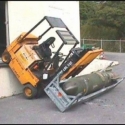|
Bgreman, how's the neutral nation integration thing going? Regarding the out-there characters, maybe I've just been too in-character serious guy, but Tildo seems a bit over the top at times. The idea is golden though. Also Spermcube and Neophyte should never stop their rants. berryjon posted:We're not invading anyone soon, right?  You never know.
|
|
|
|

|
| # ? May 14, 2024 01:49 |
|
Innocent_Bystander posted:Bgreman, how's the neutral nation integration thing going? I proposed this a while back, but no-one really commented on it so I was letting it sit on the back burner until we had a new colony lined up. "Article of Incorporation posted:The definition of Harroux Colony shall be extended to any existent, unaligned nation which elects to enter this status, with most attendant rights and responsibilities. This excepts the installation of a UN Administrator; this role will be taken by the head of the UN or such institutions as he creates to administer such functions. The prospective nation may choose to do so with one of the following methods:
|
|
|
|
Might as well hold a vote on it while there's nothing big going on. Only nitpick I have is that the last clause should indicate wether the smallest or greatest of the two criteria needs to be met. Beyond that, I'm in favour of implementing that system.
|
|
|
|
Neophyte posted:I've read that somehow, if you make a "terraformer" station with an orbital habitat component in it, you build it with your factories and not in a shipyard - so you're not constrained by slipway size and build times. But the habitat makes it loving gigantic, so it takes a LONG time to tow it anywhere. Plus it seems kinda gamey so bgreman might disallow it anyway. But anyone want to test this out? The whole purpose of the orbital habitat module is to flag a ship as buildable with a planet's industry. Beyond that you can put whatever you want on it. So yeah this totally works. Innocent_Bystander posted:Regarding the out-there characters, maybe I've just been too in-character serious guy, but Tildo seems a bit over the top at times. The idea is golden though. Also Spermcube and Neophyte should never stop their rants. FROM: The Reformatory For Make-Believe Delinquents of CO of Callisto Garrison TO: UNIN RE: Some Sort of Weird Character Tribunal My rants? Oh, you must mean my reasoned pleas for logical and measured responses on the part of the UN to counter the agenda of an unmerciful and increasingly belligerent enemy. Those rants? As for this Tildo... Well personally I am willing to overlook certain
|
|
|
|
To: UNEC From: UNCAO Long Term Oversight Subject: Lars Proen Esteemed representatives, I represent the Long Term Oversight department of UNCAO. For those who are not aware, our organization is tasked with tracking issues of high importance that have received neither satisfactory resolution, nor concrete plans, and which are not being currently discussed. When these issues are identified, we seek to represent them to the UNEC as a polite reminder that unfinished business remains, with an eye towards preventing these events from "slipping through the cracks." Think of our organization as your nagging mother-in-law who will never, ever forget a mistake you've made. As the last discussion of Lars Proen was over a year ago, we are submitting the matter of his situation for your review. Mr. Proen's continued upkeep brings costs, in the form of conventional requirements as well as in the risk that his discovery by Federation agents could cause a disastrous diplomatic incident. We ask that the UNEC to resolve the issue of Mr. Proen by providing a concrete plan for future actions with regard to him, even if this is by declaring that his current situation is acceptable for the indeterminate future until events make him relevant again. Remember, we only want what is best for our children.
|
|
|
|
From U.N Industrial Command With it looking like more who can vote are in favor of ceding Titan, we need to figure out what we can get from the Feds, because quite frankly, 20 billion space bucks is nothing. We could try and: -Eliminate the trade tax the Feds have imposed on the Saturn system. This one would probably be the easiest to get, although with the Corrundium crunch it might have some challenges. Benefits would be with more miners on Iapetus and not tax we'd be getting more Corrundium. -Purchase freighters. 20 Billion credits equates to 20,000 wealth points, with each one equaling one build point. In terms of raw conversion that means for the price of Saturn, we could ask for several of their freighters to help us off set the disparity until we can build our state Aberdeens. This would be more difficult to o since they probably will defend their space lift capacity,b ut with the abundance of corporations in Fed space, the burden would be offset by all these ships. -Get some roids. We could also request the transfer of a couple mineral rich asteroids to our control, this would be the most difficult by far, as it would be a permanent transfer to use, while we are leaving early, but it would help us out the most long term potentially, but with extra solar exploration and settlement, we might not need these asteroids. These are just some ideas on how we can squeeze stuff out of the feds. Also once the Titan population has built up a bit more, I want to start transferring fueling facilities there. I know we have a couple on Mars that would be easy to send, then we can also start shipping maintenance facilities. Also I Approve of the Articles of Incorporation with Innocent Bystandards addendum. As for Proen, hes good in his cell, once we can start an extra solar colony he's on the first boat there.
|
|
|
|
Article of Incorporation posted:The definition of Harroux Colony shall be extended to any existent, unaligned nation which elects to enter this status, with most attendant rights and responsibilities. This excepts the installation of a UN Administrator; this role will be taken by the head of the UN or such institutions as he creates to administer such functions. The prospective nation may choose to do so with one of the following methods: To: Ambassador Ceebees, UNEC Re: UN Amendment We only need one more UNEC member to sign off on this before it can be presented to the UN. I'd appreciate it if you could present it, since this is more your bailiwick then mine. As a heads-up, me and and the wife will be going to Mars for a vacation and a semi-official state visit. To: Administrator Arujei Re: A Visit I'm going to be taking a vacation to Mars. While I'm there I hope to check out the ruins myself. Please give my compliments to the Federation governor and tell him I would appreciate taking a tour of his city and sampling some of the fine Martian cuisine they've been making.
|
|
|
|
We don't know enough about what the Fed economy looks like and what their current bottlenecks and demands are, so we cannot guess what their priorities and surpluses are. for all we know they could be facing a glut of freighters and would be happy to send us some at little cost to them. my point is we shouldn't try to guess what they most would like to give us but just concentrate on what we actually want. In my opinion or priority list is: Short term, freight capacity. Medium Term, Minerals.
|
|
|
|
If we're developing a new-long range sensor, is there any niche for a cheap, high-speed patrol vessel? If we're behind the federation in terms of light craft, we can at least make up the difference in sensor range and quick intercept.
|
|
|
|
Excerpts from Belnar: In Our Time and Theirs, by Dr. Karin Rønningen, University of Oslo Belnar In Our Time  Fig. 1 The Belnar Imperium ruins on Mars, discovered independently by United Nations and Federation geological probes, sit on a broad plain near the foothills of the Tartarus Montes, on the Elysium Massif. The ruin complex is 3700 km west-northwest of Olympus Mons, 900 km souteast of Elysium Mons, and 375 km north of the northernmost of the Cerberus Fossae. 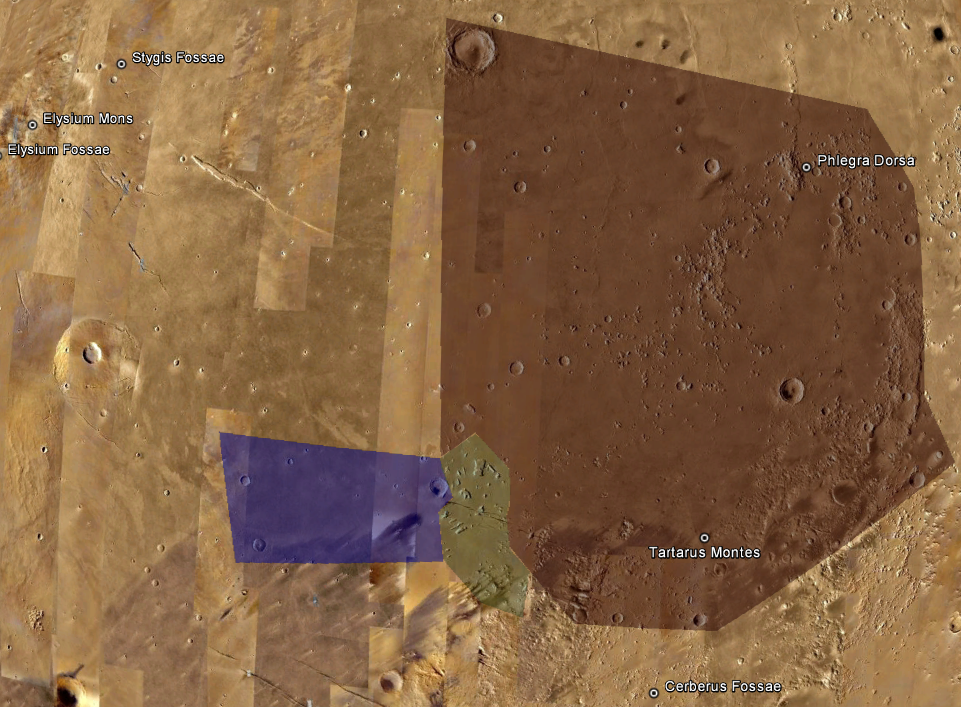 Fig. 2 The above image gives an overview of the Belnar Ruin Zone and the two governmental colonies established to investigate the ruins. The olive colored, lenticular shape in the center is the currently understood extent of the ruins. The blue zone to the west of the ruins is the UN's Mars colony. The large crater abutting the Ruin Zone is Newtown Crater (dia: 26 km), domed over by the UN and used as the primary base from which research expeditions (and facility reactivation squads) operate. The much larger red area to the north and east of the ruins is the Federation's Mars colony. The original research teams operated out of the medium sized crater just to the north of the ruin zone, dubbed Mangala Crater (dia: 16 km). The Federation arrived later to the scene on Mars, but has been far more prodigious in growing its colony. The red area is only the known extent of intensive Federation settlement (mostly in domed craters), and it is suspected that other mining and production centres exist outside this region. Most Federation administrative, commercial, and industrial capability have shifted to Lockyer Crater (dia: 68.5 km), 650 km to the north. It is estimated that 25-33% of the Federation population resides in Lockyer Crater (85% in the Greater Elysium Planitia area), with Mangala Crater retaining only a relatively small staff of scientific personnel and military engineers. 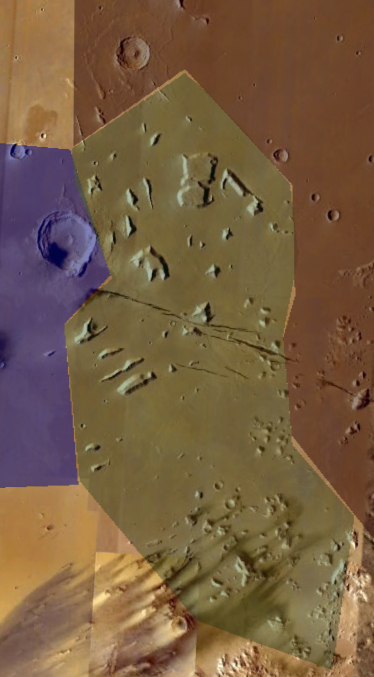 Fig. 3 Thus it is from Newtown and Mangala that most Belnar Imperium research is conducted. Newton is a bustling provincial capital of over 1.75 million citizens, while Mangala is a much smaller, specialized research outpost, with a total population of perhaps 40,000. 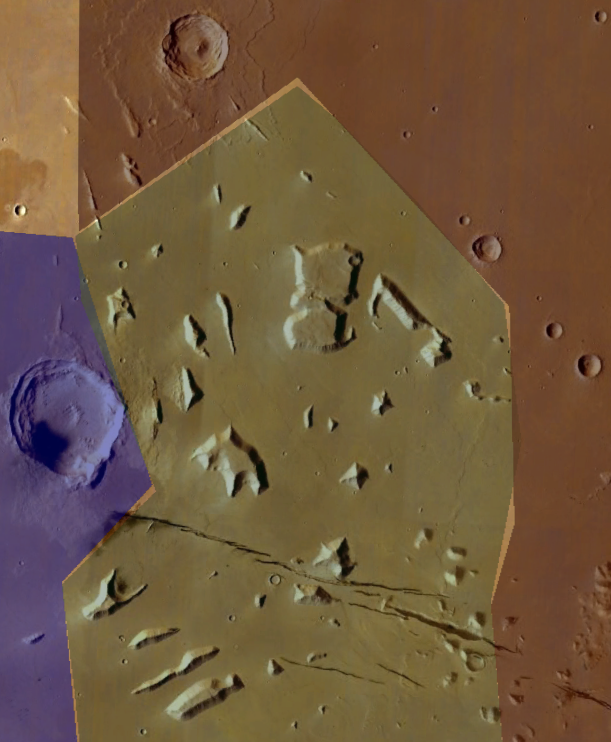 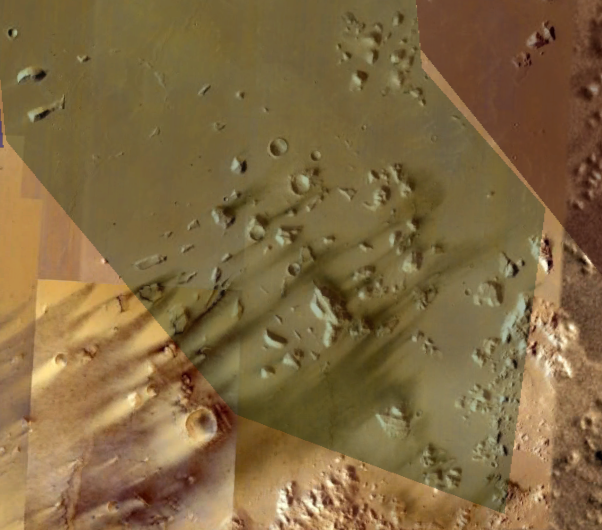 Fig. 4, 5 The Ruin Zone itself is about 215 km long from north to south, and about 85 km wide. It can be divided into two rough segments. The northen portion (Fig. 4), known as "North Oldtown" to the UN and "Angaraka" to the Federation, consists of large blocks of polygonal terrain overlying the main portion of the ruined Belnar city. The terrain features were long thought to be erosional in nature, and there are other, similar features (in Cydonia, for example) which are erosional. In fact, the features are depositional, with eons of Martian dust deposited on top of the incredibly hardy Belnar city, and then streamlied by Martian winds. A number of fossae (likely caused by the same mechanism which produced the much larger Cerberus Fossae to the south) transect the northern ruins. In fact, one of these fossae has broken the surface to such an extent that were a camera with enough resolving power to peer into the gap, a glimpse of a Belnar installation might have been obtained. Unfortunately, a sufficiently powerful imager was not deployed to Mars until well after the ruins had been discovered using Trans-Newtonian sensing technology. The southern portion (Fig. 5), known to the UN as "South Oldtown" and "Bhauma" to the Federation, contains smaller terrain features abutting the foothills of the Tartarus Montes. The surface projections of facilities here are less obvious, as they are buried deeper beneath the Martian soil than their northern counterparts. 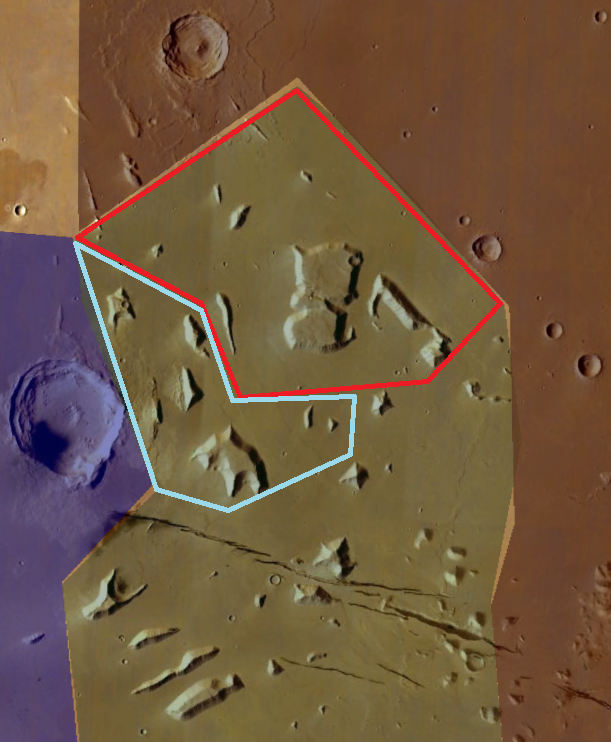 Fig. 6 While full three dimensional scans and comprehensive photographic imagery of the exteriors and interiors of all 114 Belnar buildings have been taken, active exploration has only been conducted in the areas marked in Fig. 6. The light blue area indicates the extent of UN exploration and reactivation activities, while the red area indicates those areas where the Federation has conducted its operations. Independent monitors are typically present at any unilateral investigation sites, and informal joint teams frequently trade research and ideas in the Free Mars settlement of New Belnar, in the small crater north of Newton and southwest of Mangala. Approximately 25% of the Belnar ruins on Mars have been fully explored as of June 2032, six years after the ruins were discovered. Twenty-nine installations have had reactivation attempts, with somewhere between twelve and sixteen of these attempts failing and resulting in irreparable damage to the facility, or, in some cases, its complete destruction. In some cases the failures are due to human error, but in most, the powerful forces of time have rendered even these enduring edifices irrecoverable. 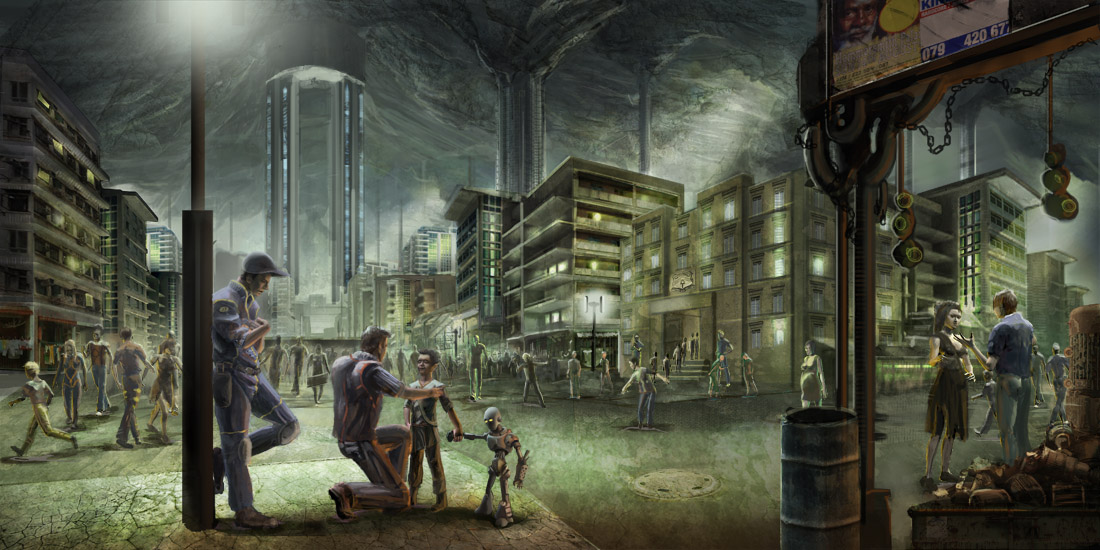 An illustration of Belnar Depths, an outlying, subterranean district of Newtown, directly abutting a recovered Belnar installation (in this case, the "roots" of an automated mining installation, tapped directly into Mars's core). The cavern's supports are from the time of the Belnar, but have been reinforced by UN engineers.  An illustration of the Federation capital on Mars, Lockyer Crater. In the foreground, a research convoy heads south for Mangala and the Belnar ruins. In the medium distance, a surface to orbit shuttle departs from the makeshift spaceport on the outskirts of Lockyer. In the background, the transparent duranium dome spanning Lockyer can be see, with the iconic Lockyer Tower administrative building towering over residential sections. Lockyer is estimated to have a population between six and eight million. Belnar in Their Own Time  An artist's conception of the Belnar city in its prime. Most of the connecting transport routes have been pounded into dust over the millennia, though traces of their connections still exist on many of the facilities. Though many (perhaps most) facets of the Belnar Imperium are a mystery to us, some things are beginning to be understood. One unequivocable facts is that 36.4 ± 3 million years ago, a spacefaring race established an outpost on Mars. It is known that the race was not native to Mars, as there exist artifacts of extra-areological provenance, based on comparative isotope analysis. In fact, the isotope distribution does not match that of any known location in the solar system, strongly suggesting an extrasolar origin for the Belnar. The precise origin of the Belnar is currently unknown, though records have been uncovered giving tantalizing hints of a relatively local origin. A tactile plaque (see below) placed on the outside of what is believed to the main Belnar administrative building in the northern ruins appears to be a star chart with a number of nearby stars highlighted. Whether any of these are the Belnar homeworld, or whether they are just other locations visited by the Belnar (or perhaps even the homeworlds of other starfaring species) is unknown. No biological specimen (either Belnar of of any other organism) has survived the ages since the Belnar city was abandoned, so a precise biological analysis of the Belnar is impossible. Based on the facilities, artifacts, and other remants, however, an incomplete picture can be assembled. Several tactile plaques contain the gross body plan: three lower appendages arranged with radial symmetry, a stout, barrel-shaped midsection, three whip-like upper appendages, and a low, domed projection from the top of the midsection. From workstation ergonomic considerations, we can deduce that the average Belnar was approximately 120 cm tall. Belnar "chairs" are more akin to low stools which take most --but not all-- of the weight-bearing load off the legs. Belnar workstations and tools are typically rod shaped, with control surfaces arranged in a spiral fashion all the way around. It is surmised that Belnar arms were long, tactile, super-prehensile appendages, tipped with a pair of opposing muscular "fingers," somewhat akin to the tip of an elephant's trunk, but more gracile. In order to operate the control rods, Belnar anatomists hypothesize that the entire surface of the arm had extremely dense ennervation and musculature, allowing fine manipulation of surfaces all along its length, with gripping of objects handled by the arm-tips and by prehensile wrapping. The primary sensory mode of the Belnar is unknown. The tactile plaques have no obvious features analagous to "eyes," though this doesn't rule out their existence. However, at the very least, the Belnar appear to be unaware of the perceptual concept of "color," as the interiors of all Belnar installations (as well as their fixtures and artifacts) have no artificial pigmentation or coloring. Every item is simply the color of its constituent materials. The leading theory is that the Belnar perceived the world primarily through their tactile sense. The surfaces of most Belnar equipment (as well as floors, walls, and sometimes ceilings) are densely covered with intricate patterns of raised and recessed markings. These markings are believed to be either written language or some more fundamental communications / information presentation protocol. In the Belnar xenology community, the term "tactograms" was coined to describe the markings. Work on deciphering these "tactograms" has been slow-going, though a small subset is thought to have a reliable correspondence established. No other form of communication has been discovered. Complicating the matter is that the static tactograms engraved into the majority of surfaces appears to be a limited subset of a more general class of tactograms. Nearly every human language is recorded using a static set of glyphs, without any extension in time. It would seem the vast majority of Belnar tactograms have a temporal component to them. The same static tactogram can apparently represent quite different notions depending on its time evolution. In this respect, the Belnar language is more akin to modern signing languages. Predominant among the evidence lending credence to the "tactile language" theory are the enormous quantity of "tactile plaques" present in the ruins. Most are electromechanical devices capable of changing their surface geometry to display tactograms. In a few extraordinary examples, an entire tank filled with a ICEF-contained Trans-Newtonian fluid is capable of acting as a three-dimensional tactile plaque, but all have quite sophisticated surface manipulation capabilities. In general, these devices are thought to be the equivalent of our raster- and vector-scanned two- and three-dimensional display screens. Some plaques are paired, with the assumption that one is for input and one is for display, but the majority seem to combine both functions into one device. It is through these plaques that we get most of our information about the Belnar. While our grasp of the tactile language is still extremely tenuous, guided trial-and-error exploration with the devices has given us access, in a few cases, to Belnar data. In many cases the retrieved data is incomprehensible until we develop a further understanding of the tactile language, other data is at a coarser scale and represents the tactile equivalent of a photograph or video. Using 3D laser scanning techniques, it is possible to adapt from a tactile plaque to a human-readable display. It is via this mechanism that we have been able to begin to interpret the vast quantities of Belnar data still existent in their electronic record systems. We have a long way to go in understanding this data, but some insights have been made into the Belnar way of life. One particular building contains dozens of tactile plaques that depict various Belnar going about their lives. Some researchers speculate that this building and its contents were specifically created to inform futre archaeologists about the Belnar, though there is nothing like a Rosetta stone to help with interpreting the imagery. For this latter reason, other xenologists suspect that the facility was a knowledge retention installation, meant to transfer useful knowledge of industrial processes to future generations. For this reason, the building has become known as the Academy. What is is depicted in the Academy is what appears to be a very communal society. Belnar work exclusively in units that Belnar xenologists have come to call Trios, with two Belnar working while one appears to supervise. However, the supervisor role is rotated regularly between members of the Trio. In virtually all industrial applications viewed in the Time Capsule, there does not appear to be any higher tier in the hierarchy; there are no foremen, no managers, and no executives. The Trio is the fundametal and only functional worker unit. Unfortunately, there are no tactile plaque depictions of leisure activities (indeed, no facilities dedicated to that purpose have yet been discovered) or Belnar home life. Whether any sexual dimorphism (or, indeed, any gender at all) exists is unknown. There are no depictions of Belnar reproduction or offspring. A work-home split has been posited due to the fact that the majority of industrial concerns are concentrated in the northern ruins, while the southern ruins seem to be group dormitories and housing facilities. It is possible that less durable single-Belnar habitations existed and have been erased by time, but that not a single trace exists, while numerous dormitories are still extant would lend doubt to that supposition. The Belnar Enigma Why the Belnar established an outpost on Mars is currently unknown. It could have been a research outpost studying any number of things (solar dynamics, life on Earth, etc). It could have been a colonial venture, though there is no indication of mercantilism or "corporations" as we know them. The mix of facilities heretofore discovered is remarkably similar to a standard mining/production outpost, and it is possible that the Belnar city's origins are that mundane. It is known that the settlement existed for approximately twelve thousand years, with the northern and southern ruin groups each expanding outward from a central nucleus site. However, to end up with such a small outpost after such a long time likely means either a deliberate attempt to keep the size of the colony small, or extreme longevity and low birth rates among the Belnar. (Some tactile plaques indicate that there were, at some point, more Belnar facilities than have survived until today, the number is still quite low when considering the length of the outpost's existence). It is also unknown whether this outpost was in constant contact with its founding entity over this time. There are no traces of agriculture or animal domestication, but it is unlikely these remains would exist after 36 million years of Martian connditions. Why the settlement was abandoned is an even greater mystery than why it was founded. The exodus was not abrupt (estimates are around 300 years from the beginning of the abandonment and the last known Belnar data entry), and the equipment was shut down in good order and sealed against the Martian environment. This suggests, perhaps ominously, the Belnar intended to return. What kept them from doing so if this is indeed the case is also unknown. It is quite possible the answers to all these questions remains hidden in the tactograms. With Belnar xenology extremely popular among young academics, we can hope that the answers will be discovered sooner rather than later. bgreman fucked around with this message at 22:55 on Oct 16, 2013 |
|
|
|
From U.N Industrial Command drat that's impressive bgreman, I really like all that back story, very interesting, especially the tactograms. That is a big mystery though, why did the Belnar leave? Was there a war and the population needed to evacuate? Were they simply a massive research colony that was eventually abandoned? Are they going to come back eventually? Who knows. However, while it is wonderful to assume that these were a benevolent race and we can meet with them, until we actually meet a peaceful alien, we might have to assume hostile until proven not. In addition, we need to look at Project Hurricane to figure out what we want to do with our fleets next. Fleets and Stuff First and foremost, we need to reexamine solely using size 1 and size 8 missiles. The former while fast, might not be enough to punch through heavy armor belts, even with a heavy dusting of saturated fire. The Size 8 missiles, while potent, have a slow rate of fire and could be shot down. We need a mid ranged missile, that can deliver a bit more firepower, but with a faster reload rate. Our civilian contractors have built up several prototype computer models for the council and greater military to examine: code:code:code:code:code:code:Other Stuff I think getting freighters would be good, because once we can start extra solar colonies, holing onto small properties or reducing a temporary tax will seem small in comparison to rushing to start homesteads in the outer systems. Again though, selling Titan would be a good idea, so we can shift mines to Iapetus and Mars. Furthermore, if we can, I'd recommend we stop buying minerals from Mimas, we're just getting Duranium and quite frankly, we're raking in plenty of it already, so having some sold on the open civilian market would be good for the private sector. Also DagPenge I would like your approval to transfer 5 Fuel Refineries to Callisto, as well as All Our Maintenance Facilities The Former needs 50,000 people each to operate,so we'll need an extra 250,000 people on Callisto, but I think if we maintain our infrastructure manufacturing and transports, it shouldn't be much of a probable,. The later don't need population, so there is no reason to keep them on Earth. Finally, everyone with characters in thread who make colorful posts...Keep up the great work, you're tireless efforts help make everything fun during the slow periods.
|
|
|
|
Councillor Added Space, Public Address, Belnar Academy I can only marvel at the history of this place. However, it somehow seems too small. There is so little energy in these ruins, so little sense of adventure and expansion. It hardly seems such a regimented society as this would ever find the imagination to cross the void between stars that they could not even see. I think that this is but the narrowest finger of much larger entity, the residents as much machinery as the mines. I think we have not yet seen the true face of the Belnar. I am saddened by the loss of history that each crumbling reclamation brings us, but I hardly think such beings would object to their structures being used as they were intended. However, places such as this must be preserved and cared for. The only thing we can truly say we shared with these beings is that we value the preservation and continuation of knowledge. Let us continue the memory of the life that left long ago, and add our own life and our own memories. I ask for the UN and the Federation to recognize this building as the first Heritage of Sentience site.
|
|
|
|
Jimmy4400nav posted:Also DagPenge I would like your approval to transfer 5 Fuel Refineries to Callisto, as well as All Our Maintenance Facilities The Former needs 50,000 people each to operate,so we'll need an extra 250,000 people on Callisto, but I think if we maintain our infrastructure manufacturing and transports, it shouldn't be much of a probable,. The later don't need population, so there is no reason to keep them on Earth. From: Coucilor DagPenge, Head of UNDOT To: Jimmy4400nav; UNEC; UNDOT RE: Transfer of facilities to Callisto Sure not a problem, I'll authorize the transport and get to moving those facilities as soon as we are able. As far as I remember moving those Maintenance Facilities requires our big freighters and those are still about 200 days out. Move 5 Fuel Refineries from Earth to Callisto. Move all of our Maintenance Facilities from Earth to Callisto, as soon as our incoming fleet is done using them. Once the Seoul Shipyard is done, rename it and give it the same orders as Sydney That should be all for me I think, unless I am the one who has to take the decision with the Federation offer. Who has authority there?
|
|
|
|
Two notes: First, maintenance facilities do require population to operate (50,000 each). Second, maintenance facilities can be moved just like any other installation, so there is no need to wait on the large freighters (of which the McKiernan has four total).
|
|
|
|
Bgreman that post is awesomeTriggerhappypilot posted:If we're developing a new-long range sensor, is there any niche for a cheap, high-speed patrol vessel? If we're behind the federation in terms of light craft, we can at least make up the difference in sensor range and quick intercept. I came up with a design brief for a scout/intel vessel in Project HERMES.
|
|
|
|
I'm not sure if it was mentioned, but with missile designs, what does the warhead value measure? How much damage does a 1 warhead missile do? If it's 1 damage, that's somewhat concerning.
|
|
|
|
TO: <UN Mailing List> FROM: Admin Arujei RE: Book Review  Welp, there go my hopes for a Belnarian princess! Perhaps the next alien race might deign to fall under the Space Princess corollary of the Drake Equation. I've offered Dr. Karen a trip to Mars on a personally chartered shuttle, to allow her a personal visit to these ruins up here. On military matters, I know my opinion counts for less than a warm bucket of piss, but having so many missiles the enemy can't even deal with them all seems to me to be a good strategy.
|
|
|
|
Volmarias posted:I'm not sure if it was mentioned, but with missile designs, what does the warhead value measure? How much damage does a 1 warhead missile do? If it's 1 damage, that's somewhat concerning. This is the case; and yes, it's very easy to run out of missiles before destroying your opponent.
|
|
|
|
Volmarias posted:I'm not sure if it was mentioned, but with missile designs, what does the warhead value measure? How much damage does a 1 warhead missile do? If it's 1 damage, that's somewhat concerning. The square root of the damage is how many layers of armor it will penetrate. WH1 missiles are sandpaper on ships and because damage is spread over the armor it takes a lot to get through even 2-3 layers of armor. Missile tech wise what do we have? For new missiles it is probably more advantageous to tech up warhead to give more room for engines/fuel before we design anything new.
|
|
|
|
apseudonym posted:The square root of the damage is how many layers of armor it will penetrate. WH1 missiles are sandpaper on ships and because damage is spread over the armor it takes a lot to get through even 2-3 layers of armor. It seems that unless we expect the Fed to deploy 2 or fewer layers of armor penetrable by a strength 4 missile multiple smaller warheads is more efficient. Myself and the rest of UNIN Special Forces will do the best we can to get Fed armor schematics, but intelligence on their mineral supply situation seems currently more strategically valuable. In order to save on engines, what's the largest number of lightweight MIRV-style warheads we can fit on a reasonably sized missile? Is that less or more effective than a greater number of size one launchers?
|
|
|
|
Bremen posted:This is the case; and yes, it's very easy to run out of missiles before destroying your opponent. So, e.g. code:What kind of missile designs are we looking at for reasonable missiles with size * 9 * 16 * 25 Our AMM seem reasonable enough but given that we know the Federation has at least partially chosen to invest into beam weapons, I think that we should be strongly considering having at least a couple ships that deliver one-shot knockout punches to at least the Moskvas.
|
|
|
|
bgreman posted:Two notes: First, maintenance facilities do require population to operate (50,000 each). Second, maintenance facilities can be moved just like any other installation, so there is no need to wait on the large freighters (of which the McKiernan has four total). Thanks for the heads up, I was just sure that some of the reason for the new transport, was to move those facilities to Callisto. However I reviewed the ZEUS notes and did not find anything, my fault! Still with the increasing population on Callisto, we better get those facilities moved and see if the population follows, now that we are shipping infrastructure there.
|
|
|
|
Volmarias posted:So, e.g. Well, you can visualize armor as a box made of squares. 4-32 means that the box has 32 columns and 4 rows, for a total of 128 squares. Missiles gouge craters in armor, so a 16 point warhead would demolish 16 squares of armor in a pattern like this: code:However, even if it doesn't do internal damage on the first hit, the armor is still damaged; if a second missile hit one of the armor columns that was already damaged it could inflict substantial amounts of internal damage. Generally the rule with missile design is that larger missiles are better at penetrating armor, but smaller missiles are less vulnerable to being shot down (since one hit will kill a size 8 missile just as well as it kills a size 1 missile).
|
|
|
|
Volmarias posted:So, e.g. Armour 4-32 means there are four rows of 32 columns each, for a total of 128 armor boxes. To penetrate this armor (i.e., score internal damage) in one shot you'd need at least 5 damage going into your central column, which first happens at strength 25. Currently, the UN gets 2 strength per MSP invested in warheads, which means you'd need at least a size 12.5 missile to do that kind of damage. However, it is very unlikely, even with using only strength-1 warheads, that you'd need to actually do 128 damage to score internal hits, as some missiles are sure to strike the same armor column. E: Beat by Bremen, most confusingly. Edit edit: The general equation to determine how many shots you'd need to have x% chance of a repeat hit on the same column is given by: number of shots needed = (ln (1.0 - % [as a decimal])) / (ln (n-1) - ln (n)) Where n represents the number of armor columns the ship has. For our 4-32 ship above, assuming we want a 50% chance for a repeat hit, we'd need to fire: number = (ln (1.0 - 0.5)) / (ln (31) - ln (32)) = 21.83 missiles, or between 21 and 22. To get a 90% chance, we'd need to fire 72 missiles. Due to the pigeonhole principle, we'd have over a 100% chance at 129 missiles. bgreman fucked around with this message at 20:08 on Dec 20, 2012 |
|
|
|
DagPenge posted:From: Coucilor DagPenge, Head of UNDOT Just remembered Stop buying minerals from Mimas If I am the one controlling that.
|
|
|
|
OK, now I understand, thanks.
|
|
|
|
FROM: Magrov, Junior Intelligence Analyst, UN embassy to the Federation TO: Whom It May Concern RE: Federation Mining Capacity I'm still crunching the mineral data recently supplied, and I made some estimations on the Federation mineral capacity on Earth and on Mars. On Earth, we are way ahead of them in mineral production. My calculations estimate that the Federation currently has a Mineral Annual Production at accessibility 1.0 of about 7,000, about 58% of our current production capacity (which is about 12,200).  The graph jumps around because the data is spotty at some times (for instance, the acceleration of the rate of growth of out production around august/2029 is due to the lack of datapoints between january/2029 and august/2029. I'll refine the graph by using cubic splines instead of linear interpolation in the future), but overall I'm pretty confident on my methodology. I've also used the data provided to estimate the Federation mineral production on Mars. According to the variation of our stockpiles and the decrease of mineral reserves, I estimate that the Federation had an average annual production of about 1,000 between january/2032 and july/2032, up from an average of about The good new is that we are ahead of the Feds in mineral output, unless they have another large mineral colony that we are not aware of, or their civilian mining colonies are much larger than ours, if they have one. The data indicates that they have no mining activity on Titan, Iapetus or Mimas. Magrov fucked around with this message at 23:27 on Dec 20, 2012 |
|
|
|
For reference, here's a picture of a ship with a 6-65 armor layout that's been shot up by dozens of strength 1 missiles. It still has about half of its armor left but it's already taken a coupld of points of internal damage from things leaking through.
|
|
|
|
Added Space posted:To: Ambassador Ceebees, UNEC My apologies for a belated and diminutive reply, i've already started traveling around for the holidays. However, I see no problem with presenting this to the UN at large and approve it on behalf of UNFRAD.
|
|
|
|
From one worldbuilder to another, I tip my hat to you, Bgreman. An excellent piece of backstory writing. In terms of official business, the Iron Duke looks the most promising (Though I have an alternative name in mind). It certainly fits the bill for a main fleet backbone, though it will be some time before we can start mass-producing them in the quantities we will need. I'd say give it a wiki page, and by the time we have a shipyard that big, we'll review and update it to the tech level we have then.
|
|
|
|
Looking at all the Belnar stuff one thing does come to mind, how did they get into our system!? We know they are not from around here and we know of only one way to use TN materials to move quickly from system to system. So did they use jump drives or jump gates? Can we somehow guess at this from the stuff we have seen on Mars? This might be why the Feds wanted Saturn so badly! there might be a fully functional jump gate there! So the question is are any of the theoretical jump spots around Saturn space inside the Federation area and how would we be able to detect the jump gate if we needed to?
|
|
|
|
I lack the years of dedicated scientific study needed to understand the actual JPT papers, but from the idiot-friendly briefings I've had on it, the prediction is that jump points, along with jump gates, are stationary relative to the star they're anchored to, partially due to the same mechanism that makes our ships require constant thrust to maintain speed, even though they're in hard vaccuum. This means that if there's a transit point near Saturn, it would be near its orbit, but not move along with the planet along that orbit. I suppose they could be wrong, but at this point is seems unlikely. It wouldn't hurt to check our Saturn sensor logs for any signatures suddenly disappearing before they're out of estimated sensor range though. The more focussed strategic JPT briefing listed three ways to spot a jump point. A: Systematically study the gravitational survey points in a system and feed that data through a quantum computer until it triangulates the points, this is what we're currently working on with our survey ships B: Have an active sensor covering the jump point while something goes through. The signature spike of a jump is quite distinctive, and from that point it's just a matter of noting down the coordinates of the jumping ship. C: Have an active sensor cover a Jump Gate, the rip in space time should show up like a christmass tree on gravity sensors. They weren't entirely certain wether this one would work at the time, but this briefing was a while back. Innocent_Bystander fucked around with this message at 11:06 on Dec 21, 2012 |
|
|
|
I would guess that while they might have had jump gates installed in our system, they must have since been destroyed by meteors/other space junk in the past million years.
|
|
|
|
bgreman, could you please add me to the list of Civilian Administrators?DagPenge posted:Looking at all the Belnar stuff one thing does come to mind, how did they get into our system!? I doubt this. I suspect that the Federation was too busy researching other things to have had time to research this by the time of the Treaty of Saturn. I think that the more mundane explanation of a resource monopoly attempt is more likely. Besides, the fact that the jump gates are "stationary" relative to our sun, rather than orbiting as the planets do, means that the Federation would only be able to control a jump point for a relatively short amount of time. It makes sense as a logistics hub that will occasionally be nearby to help with fueling and operations, but that's a bit of a stretch. On to other business: I recall that, based on the known capabilities of the Moskva and our projections of its loadouts, we have a rough idea of the component makeup of the Moskva. Does anyone know on what page that is? I'd actually like someone to model the effect of several scenarios regarding a fight between Moskvas vs Berlins or Surigao/Samar pair. In particular, what is the likelyhood of our ships killing the Moskva before it gets into beam range? How many Moskvas must be in a patrol to be statistically likely to overwhelm a lone Berlin? A Surigao/Samar pair? What about mixed groups such as two Berlins vs multiple Moskvas? I don't think that anyone has done an analysis of this, which means that our effective combat capabilities are still somewhat unknown. We also don't even have guesses for the loadouts for the Skory class, which greatly concerns me. We NEED to know this information to know how to handle our fleets in the event of a confrontation, if we want to do anything more complicated than sticking all of our boats into one task force and hoping for the best.
|
|
|
|
I have to imagine that a single Berlin would overpower a Moskva in solo combat, but a Surigo/Samar pair may lose a single ship or take damage. As far as the Skory, I should imagine that it has capabilities on par with the Berlin - perhaps with an emphasis on short range weapons as opposed to the longer missile range on our ships. For some reason, the Federation hasn't produced any in a while, which seems to indicate that they are either obsolete or not needed in Federation doctrine. Oh, and if there's any space, could I be added as a navy cadet?
|
|
|
|
Unfortunately, it's also possible that they've crashed a shipyard on a moon of Saturn, and are producing their newer designs in secret. We can see that Project ZEUS is non-trivial, but we've been getting sidetracked. If they were able to focus on getting their shipyard there, and ship minerals/resources there, it's possible. I'm concerned about the idea that a single Moskva could take out a Surigo/Samar; they're designed to work in tandem, and if the Samar is destroyed, the Surigo won't be able to actually see the Moskva to fire upon it, correct? Frankly, with the amount of damage beam weapons can do once in range, I'd say that it's most likely that either both ships survive, or neither will. As a stopgap, I recommend that naval doctrine is that while we have pairs of Surigo/Samar ships, we also have a minimum of two Samars in each pack; in this way, if one is destroyed, the rest of the pack isn't blinded.
|
|
|
|
DagPenge posted:Looking at all the Belnar stuff one thing does come to mind, how did they get into our system!? FROM: The Newsletter of CO of Callisto Garrison TO: My Four Subscribers CC: UNDOT, The List of TNE-mail Addresses I've Collected. RE: Backtracking the Belnar To Bureaucratic Boondoggle?? While I still remain skeptical about the whole "Jump Point Theory" I have read the Wikipedia page for it and am therefore qualified to talk about this. We know that interstellar travel is possible now. The Belnar ruins came from somewhere, after all and we sure didn't put them there. The only question is how these weirdos got here. All of these trendy "scientists" have taken it for granted that the aliens must have used these "Jump Points" to arrive here and that's convenient for it justifies all of their elitist navel-gazing... The truth that nobody in the mainstream journals will even talk about is that they may have just flown here old-school with a rocket. Or maybe they come from a rogue planet of some sort that passed nearby. That would explain why they founded their city on cold Mars rather than earth. I mean the xenology teams did say the Belnar were more or less equivalent to us in technology and that was years ago and here we are still limited by the speed of light... Now assuming that "JPT" is legit and the aliens arrived here via a "Jump Point" it is entirely possible that they left a "Jump Gate" somewhere in the system. People will say that, theoretically, gates are huge and we would have seen it but the Belnar city was huge too and we've been exploring Mars for 60 or so years and we never saw that until we surveyed the place with TNE sensors. Without a gravitational survey of the Solar System we simply have no idea where to begin looking for a gate and space is big, I've been there. The point is it would have been easy to miss a "Jump Gate" 'til now. It's possible that the Belnar Imperium left a trail of artifacts through the galaxy. If "Jump Point Theory" is legit. But the real question we must keep asking the "Scientific Community" is why they are so sure the presence of alien ruins on Mars vindicates their new golden calf; "Jump Point Theory." Until we get the answers we deserve I will stay skeptical. Volmarias posted:I'm concerned about the idea that a single Moskva could take out a Surigo/Samar; they're designed to work in tandem, and if the Samar is destroyed, the Surigo won't be able to actually see the Moskva to fire upon it, correct? Frankly, with the amount of damage beam weapons can do once in range, I'd say that it's most likely that either both ships survive, or neither will. The Samar/Surigao were designed to work in tandem to escort a Berlin. And the Surigao is capable of targeting an enemy ship on its own it just has very limited range. It still probably has much more range than a beam-armed ship though.
|
|
|
|
SPERMCUBE.ORG posted:The Samar/Surigao were designed to work in tandem to escort a Berlin. And the Surigao is capable of targeting an enemy ship on its own it just has very limited range. It still probably has much more range than a beam-armed ship though. I guess I understand, but we created a pair of ships where - One has an incoming missile tracker - The other has long range sensors The Berlin has both of these, so if the idea is that the Berlin is going to be the mothership while these are the escorts, why didn't we just make a ship class that didn't have either of these?
|
|
|
|
Volmarias posted:I guess I understand, but we created a pair of ships where I think we're betting on the strength of our fleet doctrine to compensate for our lack of numbers. So far as we can tell, the Moskva class was primarily designed as a solo patrol boat - that is, after all, how we've seen it used in combat. I do agree that our fleet doctrine is lacking a mid-range Destroyer type to one up the solo patrolling ability of the Moskva, but in a true fleet fight I would imagine that we have the upper hand.
|
|
|
|

|
| # ? May 14, 2024 01:49 |
|
Triggerhappypilot posted:I think we're betting on the strength of our fleet doctrine to compensate for our lack of numbers. So far as we can tell, the Moskva class was primarily designed as a solo patrol boat - that is, after all, how we've seen it used in combat. I do agree that our fleet doctrine is lacking a mid-range Destroyer type to one up the solo patrolling ability of the Moskva, but in a true fleet fight I would imagine that we have the upper hand. I hope you're right
|
|
|


